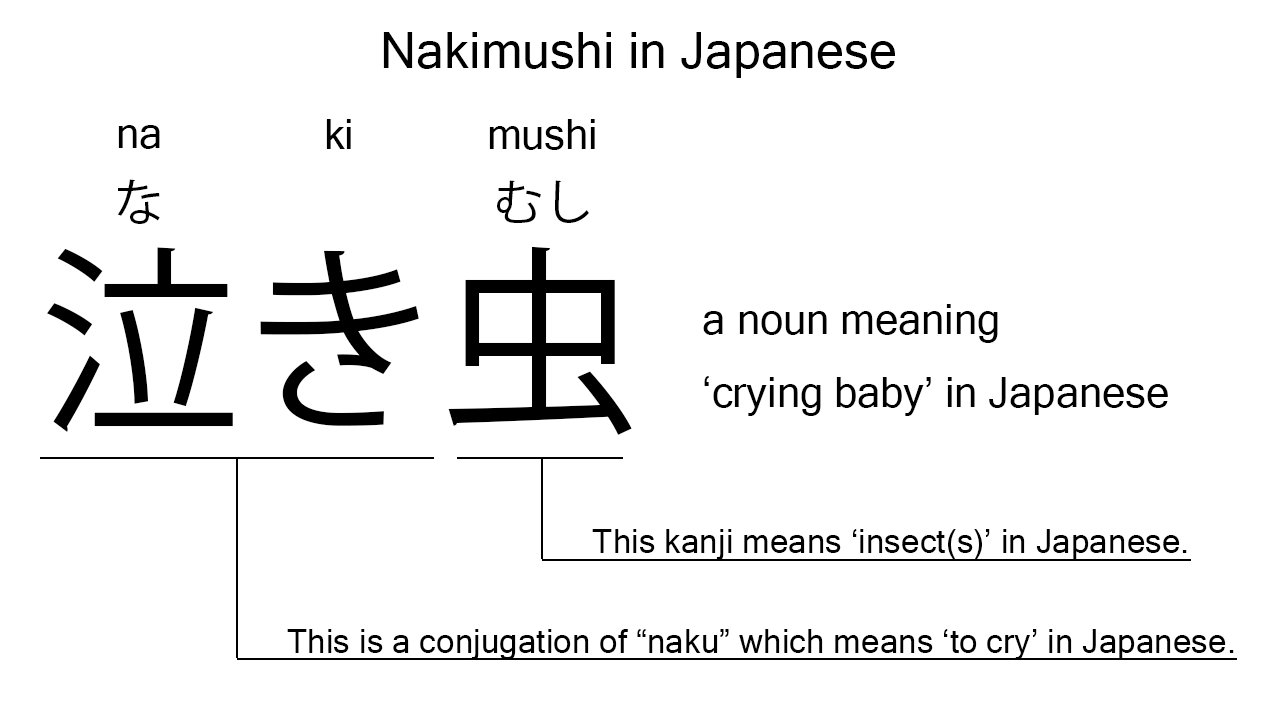What does “nakimushi” mean in Japanese?
Native speakers say “nakimushi” to mean ‘crying baby’ in Japanese. Perhaps, some Japanese learners know this word as it is sometimes used in Japanese movies, songs, novels, manga, anime, and the like. In this blog post, however, I will explain this word in detail based on its grammatical components. And also, I will explain how to use it through example sentences. My explanations would help Japanese learners understand “nakimushi” more clearly. Then, let’s get started!
Contents
Definition and meaning of “nakimushi”
Let me start with the definition and meaning of “nakimushi”.
- nakimushi – 泣き虫 (なきむし) : a noun meaning ‘crying baby’ in Japanese. This can also work as plural. Learn more about Japanese plural.
The definition and meaning are simple and clear. To understand this noun more clearly, however, let me explain its grammatical components in detail, one by one.
What does “nakimushi” literally mean?
“Nakimushi” consists of the following two components:
- naki – 泣き (なき) : one conjugation of the verb, “naku“, which means ‘to cry’ in Japanese.
- mushi – 虫 (むし) : a noun meaning ‘insect’ or ‘bug’ in Japanese.
These two components tell us that the formed noun literally means a ‘crying insect’ in Japanese. This literal interpretation is not in line with the actual meaning, but still understandable. In Japanese, interestingly, “mushi” is sometimes used as a metaphor for those who are not strong.

When we meet new Japanese words, we should check their grammatical components in detail to understand their meanings clearly and deeply. In many cases, components tell us a lot about the meanings of the words they form. Actually, here, we could get the better understanding of “nakimushi” through the detailed check above.
So far, I’ve explained the definition and meaning of “nakimushi” together with its grammatical components. Then, let me explain how to use it through the example sentences below.
Example #1: how to say “crying baby” in Japanese
kanojo wa nakimushi desu – 彼女は泣き虫です (かのじょはなきむしです)
She is a crying baby.
Below are the new words used in the example sentence.
- kanojo – 彼女 (かのじょ) : a pronoun meaning ‘she’ in Japanese.
- wa – は : a binding particle working as a case marker or topic marker. In the example, this works after “kanojo” to make the subject in the sentence.
- desu – です : an auxiliary verb used after a noun or adjective to make it polite. Probably, this is well known as a part of Japanese desu form. In the example, this is used after “nakimushi” to make it sound polite.
This is a typical usage of “nakimushi”. In this example, it works as the complement in the sentence.
Example #2: another usage of “nakimushi”
「watashi wa nakimushi desu」 to kanojo mo it ta – 「私は泣き虫です」と彼女も言った (「わたしはなきむしです」とかのじょもいった)
“I’m a crying baby,” she said too.
Below are the new words used in the example sentence.
- watashi – 私 (わたし) : a pronoun meaning ‘I’ in Japanese.
- to – と : a case particle working as a quote marker. In the example, this works after the clause to indicate what she said.
- mo – も : a binding particle making the subject word or the object word in a sentence with adding the meaning of ‘too’, ‘also’, or ‘as well’. In the example, this works after “kanojo” to make the subject in the sentence with adding the meaning of ‘too’.
- it – 言っ (いっ) : one conjugation of the verb, “iu“, which means ‘to say’ or such in Japanese. In the example, it has been conjugated for the better connection with its following word.
- ta – た : an auxiliary verb used after a verb, adjective, or auxiliary verb to make its past tense form. In the example, this is used after “it” to make its past tense form, “it ta”.
This is another typical usage of “nakimushi”. When we want to mean a ‘crying baby’ in Japanese, this noun is always a very good option.
Summary
In this blog post, I’ve explained the definition and meaning of “nakimushi” in detail based on its grammatical components. And also, I’ve explained how to use it through the example sentences. Let me summarize them as follows.
- nakimushi – 泣き虫 (なきむし) : a noun meaning ‘crying baby’ in Japanese. This can also work as plural. This noun literally means a ‘crying insect’ in Japanese. This literal interpretation is not in line with the actual meaning, but still understandable. In Japanese, interestingly, “mushi” is sometimes used as a metaphor for those who are not strong.
Hope my explanations are understandable and helpful for Japanese learners.